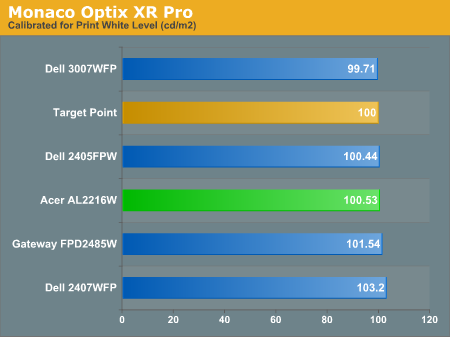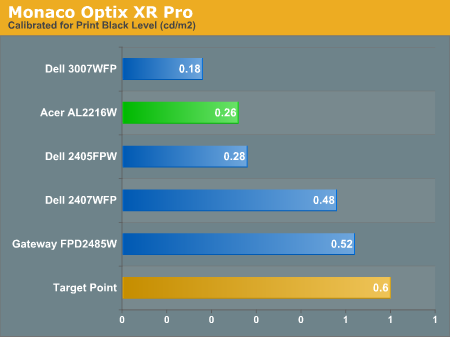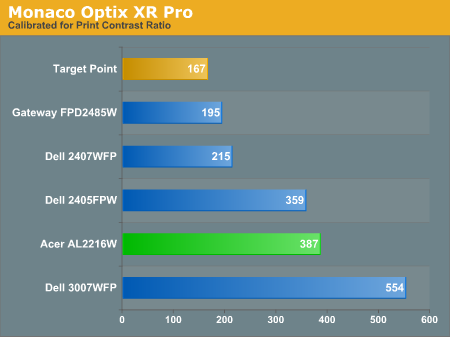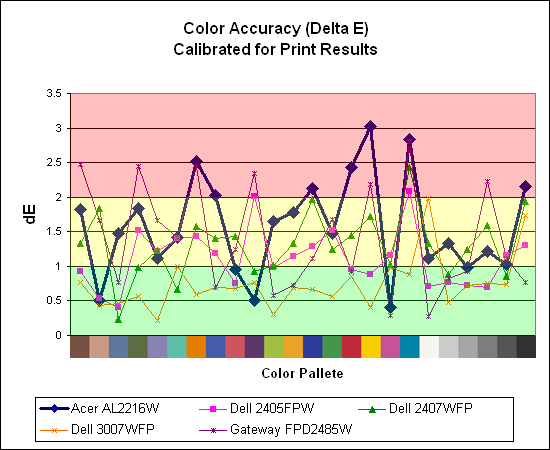Acer AL2216W: a worthwhile compromise?
by Jarred Walton on March 10, 2007 3:00 PM EST- Posted in
- Displays
Printing Results
Brightness and Contrast Ratio
Using the standard calibration procedures works well if you only plan on using your computer with online data. In fact, you can generally set what ever brightness and contrast levels you want and then let the calibration software adjust the color profile as appropriate (although depending on the display certain settings will produce more or less accurate colors). However, many image professionals also have a need to match colors between their computer displays and their printers, and what works well for computing purposes often isn't the best suited for doing print related work. To help people who work in such areas match their computer colors to their paper colors better, some standards were established. Generally speaking for print work the standard is a gamma of 2.2 (some people recommend 1.8, but we'll use 2.2), a black point of 0.60 cd/m2, and a white point of 100 cd/m2.
Finding the appropriate settings to reach these levels can be a time-consuming process. Numerous iterations through the calibration process are required in order to end up with the desired white point, and on some LCDs it might not even be possible to reach a satisfactory result. We were unable to get both an accurate white point and an accurate black point according to printing requirements (our black levels always ended up darker than they were supposed to be) but eventually we did manage to get the desired 100 cd/m2 white point on all of the tested displays. This required adjusting the individual color levels on most of the displays (the Dell 3007WFP doesn't give this option). Here are the settings we ended up using for these monitors:
Dropping just the brightness on the Gateway FPD2485W and Dell 2407WFP did not reach the required white point, in the case of the former not by a long shot. We also found that dropping the brightness level to zero and then further reducing the color levels did not generate desirable results. We were most successful when we set the color levels to a moderate value and then tweaked the brightness and color levels as necessary to get the desired result. Here's how the brightness and contrast ratios changed with these tweaks.



We were not attempting to get 100% accuracy on the white point, but further tuning of the various displays would have likely made it possible to get closer to 100 cd/m2. The primary goal was to merely get the white point down to close to 100 cd/m2 if possible. The target black point on the other hand is much more difficult to achieve once we have reached the target white point. Due to the reduced brightness level, contrast ratios are lower, but that is expected with print material. For reference, we have included the target values in the above graphs, so the greater the deviance of the display from the targeted value, the less suitable for display becomes for print work. Having calibrated the displays for printing, let's see how they actually fare.
Color Accuracy
Given the importance of accurate colors for printing work, we have adjusted the Delta E scale appropriately. A Delta E of less than 1.0 is definitely the goal here, and 1.0 to 2.0 is merely acceptable. Scores above 2.0 basically mean that the display is not fit for printing professionals.


Again the Acer AL2216W is the lowest score in this grouping, but we were somewhat surprised with the results we were able to achieve with all of these monitors. With default brightness levels seemingly increasing with every display generation, we weren't sure we'd be able to come anywhere near the desired colors at such a low white point.
The Acer and Gateway displays took the most time to properly calibrate, as it was necessary to spend a lot more effort tweaking the individual colors. Given how bright the Gateway FPD2485W is by default, we were happy to find that customizing the color levels allowed us to reach a more or less acceptable level. While the Acer and Gateway still place at the bottom of the pack in terms of printing color accuracy, they're at least somewhat close to the 1.0 threshold. The Dell 3007WFP is clearly the best out of these displays for printing work, with a very low average Delta E and only two individual scores (pure white and pure black) that were above 1.0 (and still below 2.0).
Brightness and Contrast Ratio
Using the standard calibration procedures works well if you only plan on using your computer with online data. In fact, you can generally set what ever brightness and contrast levels you want and then let the calibration software adjust the color profile as appropriate (although depending on the display certain settings will produce more or less accurate colors). However, many image professionals also have a need to match colors between their computer displays and their printers, and what works well for computing purposes often isn't the best suited for doing print related work. To help people who work in such areas match their computer colors to their paper colors better, some standards were established. Generally speaking for print work the standard is a gamma of 2.2 (some people recommend 1.8, but we'll use 2.2), a black point of 0.60 cd/m2, and a white point of 100 cd/m2.
Finding the appropriate settings to reach these levels can be a time-consuming process. Numerous iterations through the calibration process are required in order to end up with the desired white point, and on some LCDs it might not even be possible to reach a satisfactory result. We were unable to get both an accurate white point and an accurate black point according to printing requirements (our black levels always ended up darker than they were supposed to be) but eventually we did manage to get the desired 100 cd/m2 white point on all of the tested displays. This required adjusting the individual color levels on most of the displays (the Dell 3007WFP doesn't give this option). Here are the settings we ended up using for these monitors:
| Calibrated for Print Settings Gamma 2.2, White 100 cd/m2, Black 0.60 cd/m2 |
|||||
| Acer AL2216W | Gateway FPD2485W | Dell 2405FPW | Dell 2407WFP | Dell 3007WFP | |
| Brightness | 80 | 100 | 50 | 100 | 25 |
| Contrast | 80 | 100 | N/A | N/A | N/A |
| Red | 40 | 32 | 7 | 49 | N/A |
| Green | 39 | 32 | 10 | 50 | N/A |
| Blue | 39 | 32 | 11 | 46 | N/A |
Dropping just the brightness on the Gateway FPD2485W and Dell 2407WFP did not reach the required white point, in the case of the former not by a long shot. We also found that dropping the brightness level to zero and then further reducing the color levels did not generate desirable results. We were most successful when we set the color levels to a moderate value and then tweaked the brightness and color levels as necessary to get the desired result. Here's how the brightness and contrast ratios changed with these tweaks.



We were not attempting to get 100% accuracy on the white point, but further tuning of the various displays would have likely made it possible to get closer to 100 cd/m2. The primary goal was to merely get the white point down to close to 100 cd/m2 if possible. The target black point on the other hand is much more difficult to achieve once we have reached the target white point. Due to the reduced brightness level, contrast ratios are lower, but that is expected with print material. For reference, we have included the target values in the above graphs, so the greater the deviance of the display from the targeted value, the less suitable for display becomes for print work. Having calibrated the displays for printing, let's see how they actually fare.
Color Accuracy
Given the importance of accurate colors for printing work, we have adjusted the Delta E scale appropriately. A Delta E of less than 1.0 is definitely the goal here, and 1.0 to 2.0 is merely acceptable. Scores above 2.0 basically mean that the display is not fit for printing professionals.


Again the Acer AL2216W is the lowest score in this grouping, but we were somewhat surprised with the results we were able to achieve with all of these monitors. With default brightness levels seemingly increasing with every display generation, we weren't sure we'd be able to come anywhere near the desired colors at such a low white point.
The Acer and Gateway displays took the most time to properly calibrate, as it was necessary to spend a lot more effort tweaking the individual colors. Given how bright the Gateway FPD2485W is by default, we were happy to find that customizing the color levels allowed us to reach a more or less acceptable level. While the Acer and Gateway still place at the bottom of the pack in terms of printing color accuracy, they're at least somewhat close to the 1.0 threshold. The Dell 3007WFP is clearly the best out of these displays for printing work, with a very low average Delta E and only two individual scores (pure white and pure black) that were above 1.0 (and still below 2.0).










32 Comments
View All Comments
JarredWalton - Monday, March 12, 2007 - link
Newegg lists a http://www.newegg.com/Product/ProductList.asp?Subm...">bunch of 22" LCDs, with the Acer AL2223Wd and Chimei 221D being the cheapest. Actually, I'm curious as to what the difference in panel is between the AL2216Wbd and the AL2223Wd, as the latter has a better stand IMO. Looks like it has a slightly higher contrast as well - possibly a better display coating? Anyway, you can see in that list that specs are almost all identical between the 22" LCDs, so price and features are going to be the big factors.tercathian - Sunday, March 11, 2007 - link
w/ Base, (WxHxD)=20.2"x16.0"x7.8"; w/o Base,=27.16"x17.70"2.93". That base must reeaally scrunch things together! Otherwise another great Anandtech review. Glad to see monitors getting coverage again for a change.Upon visual comparison of BesBi's display lcd's, I passed on the Acer 22" that had a white line running top to bottom and picked the LG 22". Noticably crisper than any other brand, with purported 3000:1 contrast, for not much more $$$.
JarredWalton - Sunday, March 11, 2007 - link
Oops... yea, wrong display on the w/o stand measurements! I updated the size figures, for those that are interested. I'll also see about getting that LG LCD for review - looks interesting, as they may actually use something other than a TN panel.semo - Sunday, March 11, 2007 - link
1st, the color gradient for the gateway display links to the dell 2405fpw's (page 6).how does the dell 2405fpw look with an average delta e of 10.41? do you look at it and say "hmmm... something's wrong" even if there is no other display to compare it with? just wondering if a home user can detect color inaccuracies and do something about it or you get what you get and hope for the best (i assume a "home user" does not have access calibration equipment).
for the last several years i've largely ignored anything that has happened in display technology (other than glance over price tags) so imagine my surprise when i decided to bring myself up to date and found the crt is virtually extinct. i bought my pc and tv 5 years ago and crt was everywhere. i always thought i wouldn't switch to the thin stuff for decades and that my next tv would be a cheap hd ready tube.
anyway, i was wondering when will we see picture quality as good as crt used to provide and is lcd or plasma going to bring it to us. some of the displays at consumer shows seem to deliver the goods but anything that isn't plasma or lcd at the moment is just vaporware.
JarredWalton - Sunday, March 11, 2007 - link
Thanks for the link correction; that's fixed now for the Gateway chart.I'm not sure if the colors on the 2405FPW are just getting worse due to age or if it's always been off that far. If it's sitting next to another display display, I can certainly see a difference and the 2405 tends to look a bit washed out/yellow. If it's sitting alone on a desk, it actually doesn't bother me much, and going through some basic color calibration charts (i.e. calibrate by eye without the colorimeter) you can improve the colors to the point where it's about the same as the other displays (around 6-8 average delta E).
CRTs are dead/dying I think in part because they can't really be any cheaper to produce anymore. Even with current LCD prices, I'd wager the markup on all LCDs continues to be pretty good, while CRTs probably don't get more than a 10-20% markup because the market won't bear it. Especially quality CRTs cost quite a bit more to manufacture, and the companies that used to make such displays (Sony, NEC, etc.) have abandoned the CRT market as far as I'm aware.
yyrkoon - Sunday, March 11, 2007 - link
I still think 22" WS monitors cost too much, you can get a decent 19" WS for $179, so why the $100 markup for 3" diagonal ? It certainly cant be assurance against dead / stuck pixels . . .This is another problem I have with paying so much , eTailers, and manufactuers saying "must have 8 dead pixels, or more to replace monitor for a new one". That would be like me saying, "hey man, most of my money is not counterfit, but some of it is, but you can not have your monitor back, becasue you dont have a high enough percentage of bad vs good currency". Would be nice if these 'people' would come around to reality, this is the main reason I personally go through convoltions, every time I plunk down a good bit of my hard earned cash for a LCD . . .
I've yet to get any dead / stuck pixels, but I figure, it is just a matter of time. Anyhow, would be nice, if 'we the people' could 'rectify' this.
JarredWalton - Sunday, March 11, 2007 - link
The eTailers are just trying to protect themselves, and there's a simple solution: if you can't live with a few dead pixels, shop somewhere else. Local stores usually cost more but have better return policies.As for the cost, I paid $1100 for a 2405FPW 18 months back, and $300 for a rather lousy 19" LCD about the same time. Needless to say, while $300 may still be more than some people are willing to pay, prices have become much more reasonable across the board. It wasn't that long ago that 19" LCDs were at the $300+ price point for entry level models, and still people were willing to buy them.
yyrkoon - Sunday, March 11, 2007 - link
I understand WHY eTailers do what they do, but my whole point is basically, why are these companies (OEMs) getting away with what is obviously 'bad business'. I suspect this has to do with some 'fair trade' garbage, something a long the lines of why 3rd world countries are allowed to import food products into countries, that would not normally allow this food in to begin with ( IE, the food does not meet the countries standards for health and wellfare ).As for the bad 19" for $300, well, I too also paid ~$300 for one of mine (ViewSonic VA1912wb) around 12-18 months ago, and could not possibly be more pleased with it. Well, ok, maybe if it were free . . . Now, could you imagine, if you just spent $650 on a 24" WS, and had noticable bad pixels ANYWHERE on the screen ? Me, I'd be very upset.
All I'm really saying, is that 'we' need to let the OEMs this is not acceptable, until then, they will get away with whatever we let them get away with.
mindless1 - Monday, March 12, 2007 - link
It's real simple, they either have to sell the panels with the bad pixels or discard them (throw away if bad enough or divert to lower grade sales which is also a loss).If they take back these panels then it will cost more per monitor. They're not "getting away" with anything, if you don't like it don't buy their product. That's the catch, they can stipulate any return policy they like and won't have to alter it if they don't preceive it hurting sales.
It doesn't really hurt sales much because there aren't that many monitors with that many bad pixels, apparently they already sort the panels well enough that the sort criteria is lower than the defective product return criteria.
They're only getting away with it if/when someone actually has that many dead pixels. Who do you know that does? Unfortunately a lot of businesses have policies that (if I knew about them), would make be pause before doing business. You end up playing odds, what is your time worth to find a better policy and what other compromises are made with the alternative product? I have one LCD of several that has one stuck pixel. I can accept that as much as I can accept a bug in some other piece of hardware, as most hardware isn't perfect, it's just a matter of whether you notice the flaw or not.
yyrkoon - Sunday, March 11, 2007 - link
All I'm really saying, is that 'we' need to let the OEMs _know_ this is not acceptable, until then, they will get away with whatever we let them get away with.Anyhow, IM sorry that my little rant here, kind of hijacked the idea of this discussion area :/ It just seems, that 'the business', is slowly, but surely moving to a 'screw the cutomer for what they're worth' type attitude, and of course, this . . . sucks.
The good news is: From all the reviews of read on acer monitors over the last few months, have been very favorable on their behalf, at least concerning dead/stuck pixels, other issues do seem to pleague random models however, such as LCD not comming up until windows is booting (need to change BIOS settings ? SoL buddy . . .), to others not working properly with dual monitors attached to a video card ( monitor not operating at 'optimal' resolution).
Some of these issues would not likely bother the average user, while it would effect those who do need to adjust BIOS settings (without hooking up another monitor), or run dual monitors, etc, etc.